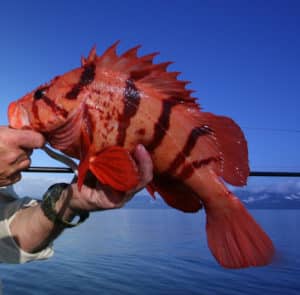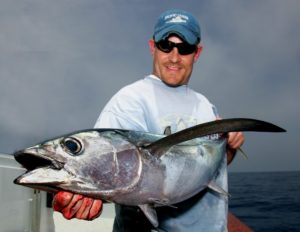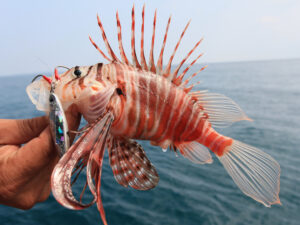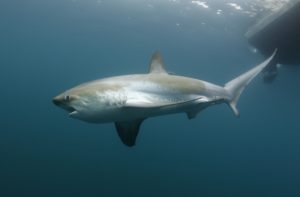Black Hawkfish Down
QUESTION:
Jack Leverone caught this small fish while casting from shore near Kailua Kona, Hawaii. What is it?
Capt. Dale Leverone
Kona Deep Sea Fishing
Kailua Kona, Hawaii
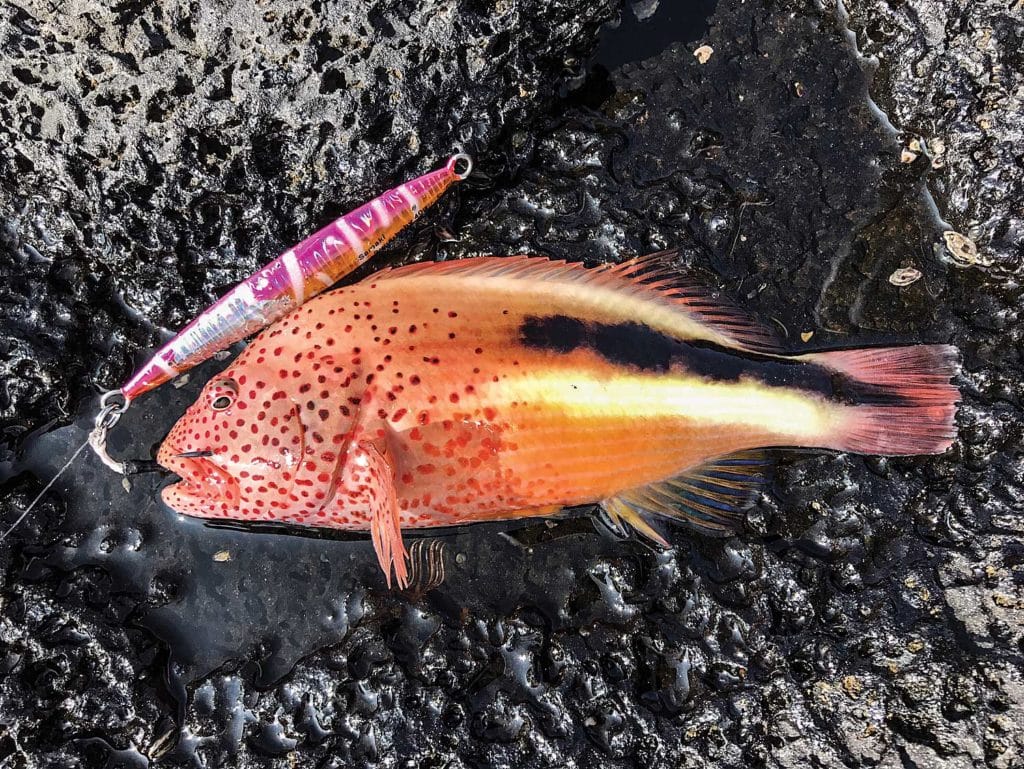
ANSWER:
What Jack caught there is a beautiful little blackside hawkfish (Paracirrhites forsteri). Also known as the freckled hawkfish, this species occurs throughout the Indo-Pacific region from the Red Sea and East Africa to the Marquesan Islands, north to Japan, and as far south as northern Australia and New Caledonia. Normally found along shallow coral reefs or lagoons perching on corals in depths of less than 100 feet, blackside hawkfish are aggressive little predators (as your photo below shows), feeding mainly on smaller fishes as well as shrimp and crabs. They grow to only around 8 to 9 inches long, but what they lack in size, they more than make up for in vivid color and variety. Jack’s fish portrays only one of several color phases this species can display, with the colors varying markedly during growth. As adults, they change sex from female to male, further adding to color confusion; some of the variants have mistakenly been described as new species.
—Ben Diggles
No-Bill Ballyhoo
QUESTION:
While fishing for bait in South Biscayne Bay in Florida, we caught this unidentifiable baitfish mixed in with our other, targeted baits. Any idea what this is?
Larry Berryman
Miami, Florida
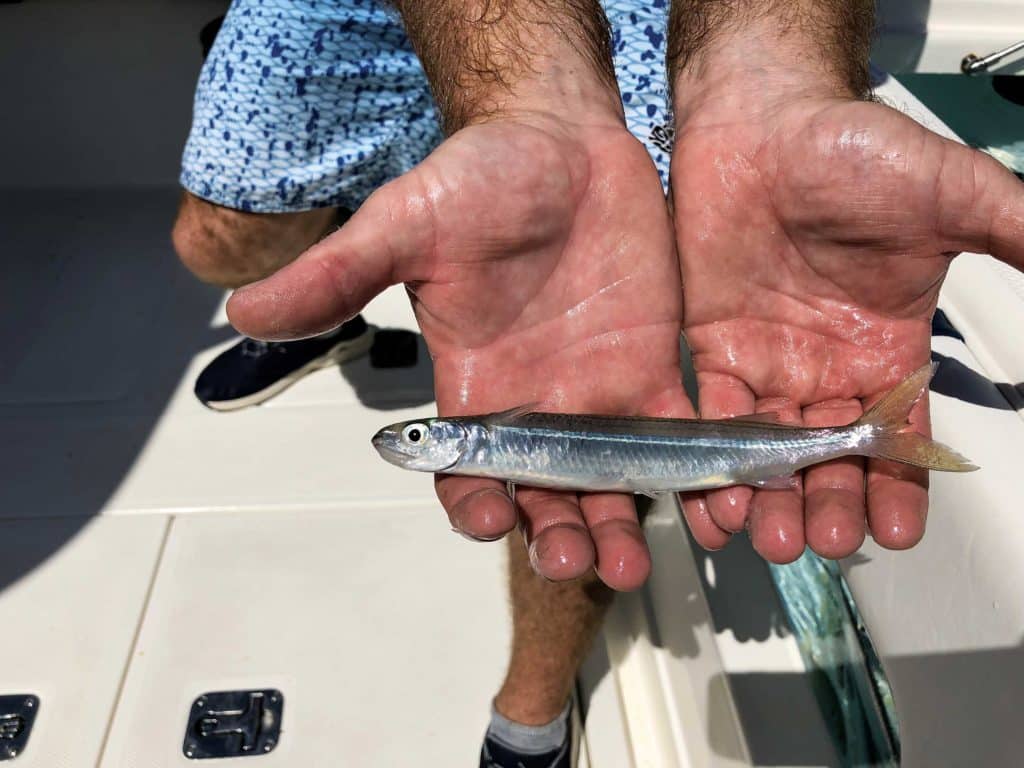
ANSWER:
Your catch is a bit different than its often-encountered cousins, Larry. It’s a hardhead halfbeak, Chriodorus atherinoides, which belongs to the same family (Hemiramphidae) as the more-familiar ballyhoo (Hemiramphus brasiliensis) and balao (H. balao), common baitfishes in South Florida. The hardhead halfbeak is a small species, reported to reach a maximum length of less than 10 inches. It has been reported from South Florida through the Keys and the Gulf of Mexico, as well as in portions of the northern Bahamas, Cuba, and around the Yucatan Peninsula of Mexico and adjacent portions of Belize. While of no commercial value at present, it was apparently a popular panfish in the late 1800s. It’s often found in association with sea-grass beds, and is common in brackish-water lakes in the Bahamas.
—Ray Waldner
The Emperor’s Oversize Orbs
QUESTION:
I caught this Mozambique large-eye bream in the southern Maldives in October 2016. I’ve never seen anything like it, and I’ve fished quite a few places. Can you tell me what it’s related to and where else it lives?
Steve Wozniak
Alamo, California
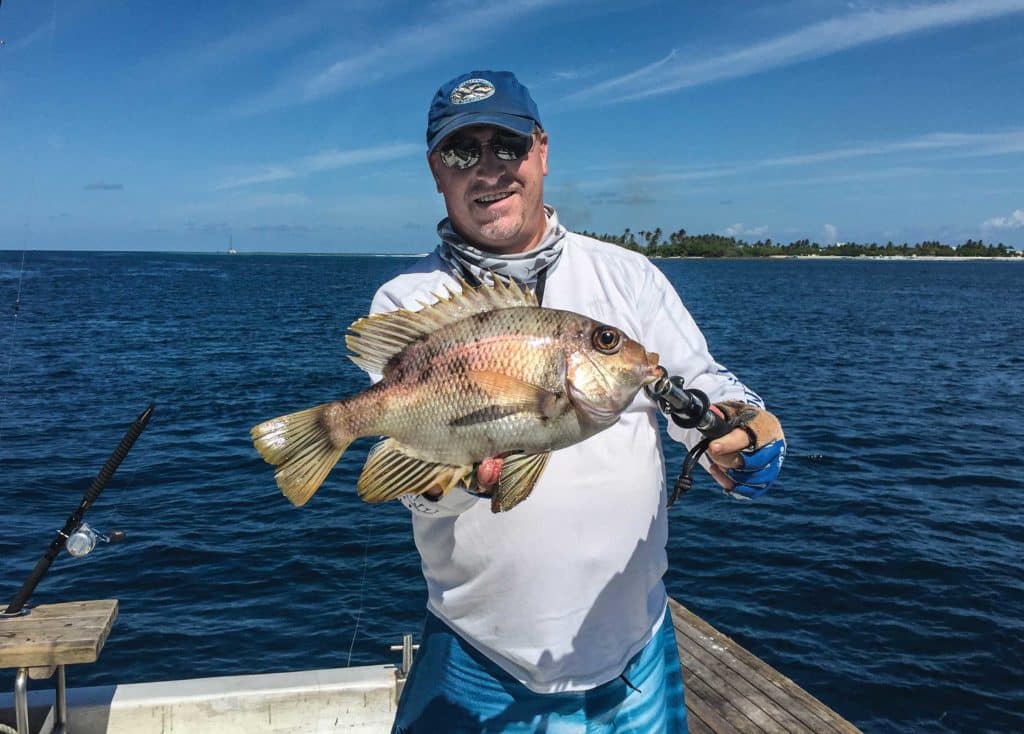
ANSWER:
Great catch, Steve! The Mozambique large-eye bream (Wattsia mossambica) is a relatively rare and rather-robust tropical emperor (family Lethrinidae). Also known as large-eye seabream, this species is the only member of the genus Wattsia, being (described scientifically) relatively recently by Professor J.L.B. Smith from South Africa, fishing in the deepwater near-reef structure off Mozambique in 1957. This species is now known to occur in various discreet locations near coral-reef drop-offs throughout the tropical West Indo-Pacific region from East Africa to Japan, New Caledonia and northern Australia. Like other lethrinids, it is a bottom-dwelling species that feeds on crabs, shrimp, other benthic invertebrates and small fishes. This species is usually taken line-fishing in water between 300 and 600 feet deep, and grows to around 22 inches long. These large-eye bream are good eating but need to be handled with care; their dorsal and anal spines are very strong and sharp.
—Ben Diggles
Trigger Happy
QUESTION:
I’ve fished all my life and have caught a lot of triggerfish. The largest I’ve encountered would barely hit 2 pounds, until this beast. It weighed in at 7 pounds. I caught it on 15-pound line, fishing cut bait in 135 to 150 feet of water off Kailua Kona, Hawaii. Is this a special breed of trigger? Or perhaps a granddaddy of them all?
Chuck Okazaki
Via email
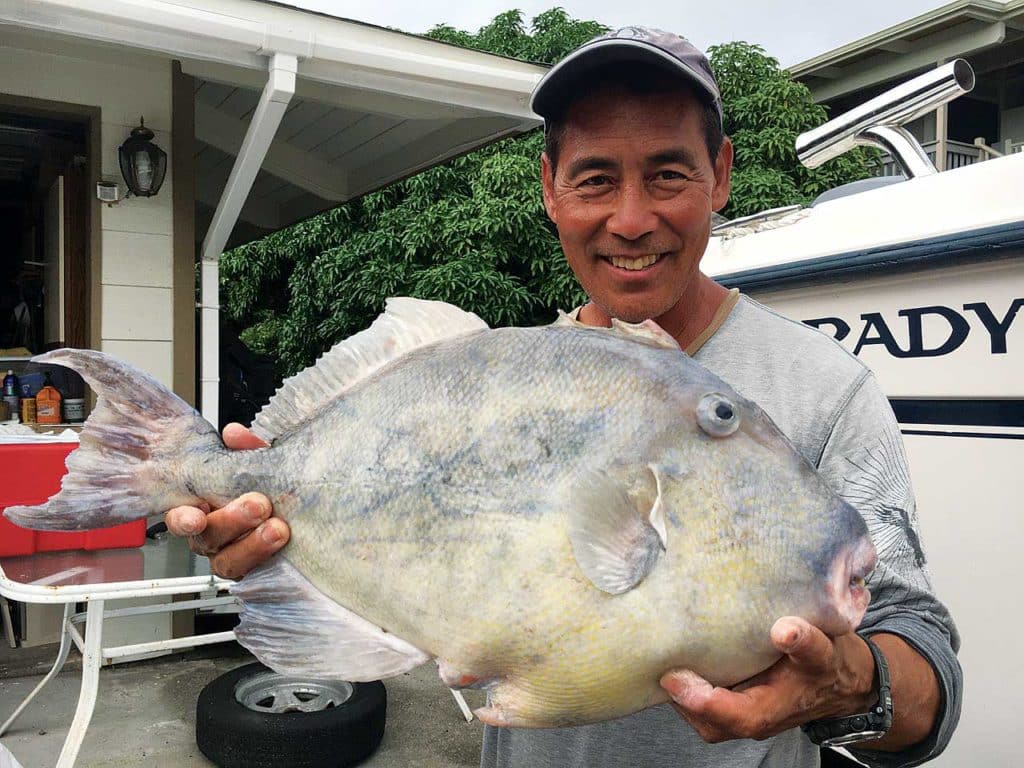
ANSWER:
Nice fish, Chuck! That looks like a finescale triggerfish (Balistes polylepis). The species occurs throughout the eastern Pacific from San Francisco to Chile and west to the Galapagos Islands and Hawaii at depths to 200 feet. Juvenile finescale triggers are pelagic, found under flotsam, but adults are bottom dwellers frequenting sand or rubble patches near coral or rocky reef habitats, feeding mainly on benthic invertebrates such as shrimp, crabs, sea urchins, mollusks and worms. Like other triggerfishes, it’s a nesting species that lays its eggs in the summer months in nests on the bottom scraped out of sand or rubble substrates and guarded by the females. While finescales are indeed one of the larger triggerfishes, growing to around 30 inches long, your 7-pound fish is about half the IGFA all-tackle record of 16 pounds, 4 ounces, also taken in Hawaiian waters, back in 2013. As for the title of “granddaddy of the triggerfishes,” that would probably be shared among the finescale triggerfish; the titan triggerfish, Balistoides viridescens, which grow to the same size (females guarding nests reportedly have attacked divers); and the stone or blunthead triggerfish, Pseudobalistes naufragium, which is the longest in the triggerfish family (Balistidae), growing to around 40 inches long.
—Ben Diggles
A Runt Among Grunts
QUESTION:
While I was on a long-range trip in the Gulf of Mexico, our mate explained that the red grouper they catch on Pulley Ridge often have a slender baitfish with yellow stripes in their stomachs. They hadn’t seen these small fish anywhere else. I dropped down a sabiki rig baited with small pieces of shrimp and found these little guys to be pretty plentiful among the weeds on the bottom. Can you help me with an ID?
Dominick Porcelli
Lighthouse Point, Florida
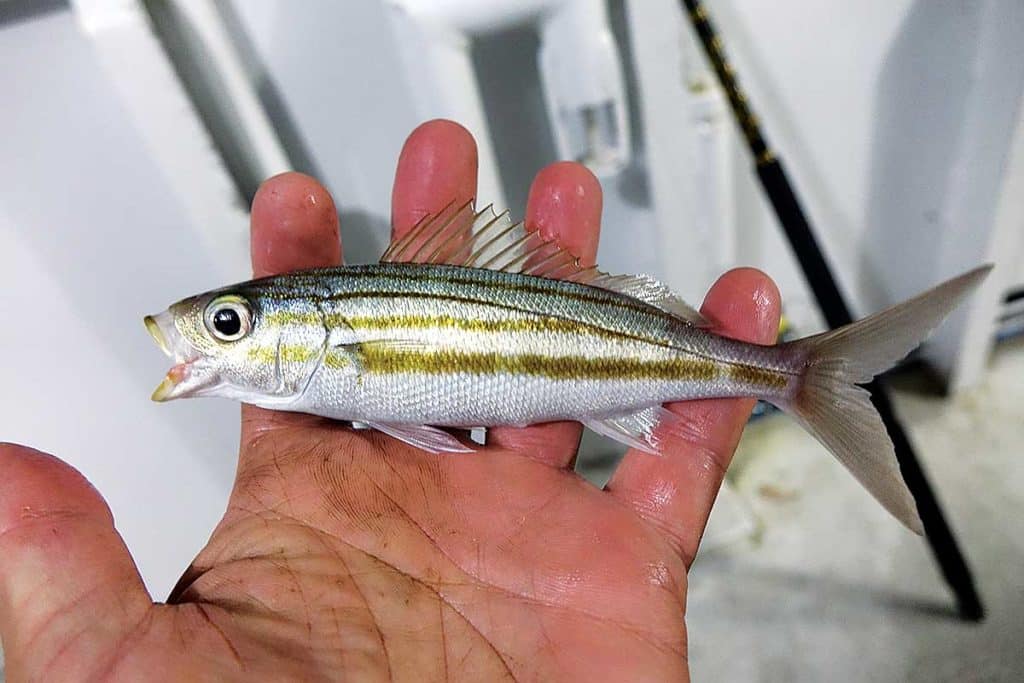
ANSWER:
You were catching boga, Haemulon vittatum, a rather unusual species of grunt (family Haemulidae). Unlike most grunts, which live and feed close to the bottom, the boga is an open-water schooling species that feeds on planktonic animals and other small organisms, including fish. The boga is so atypical for a grunt that, until fairly recently, it was considered to belong to a different family (Inermiidae, the bonnetmouths). The boga’s maximum length is just over 9 inches, although the average size is somewhat smaller. It ranges from South Florida through northern South America, including the Bahamas and Caribbean. While small, it’s sometimes marketed as food and is also used for bait.
—Ray Waldner
Scad Company
QUESTION:
We caught this while jigging oil rigs in Louisiana where the depth was about 500 feet. It looks a lot like the goggle-eyes we catch off Florida. What is it?
Jason Arnold
Fort Lauderdale, Florida
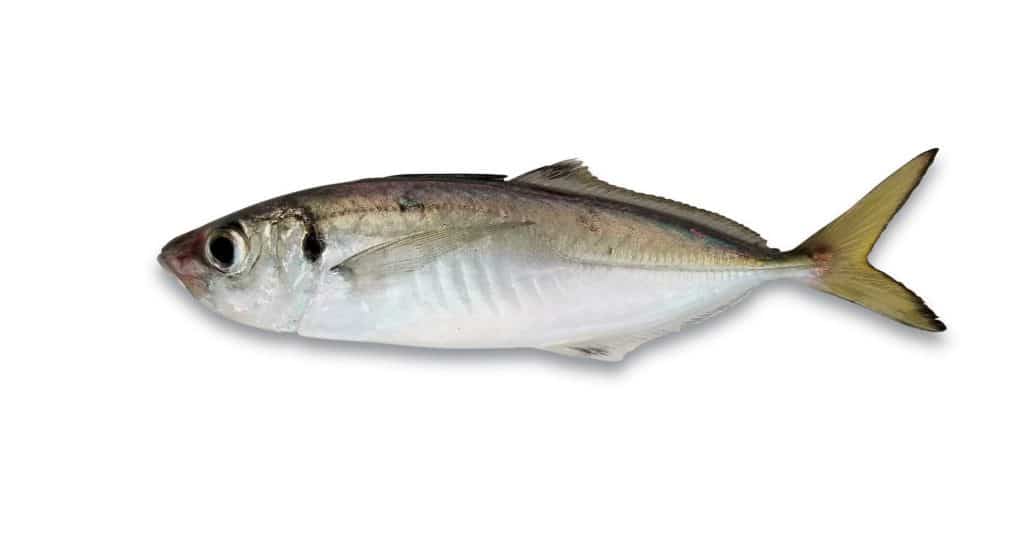
ANSWER:
Jason, there are several possibilities. Your guy is one of about a half-dozen mini-size jack species that all look pretty much alike. Of course, for us anglers, the most common and abundant of these is properly called a round scad but is more commonly known as a cigar minnow, the finest king mackerel bait available. All these species have the black spot on the operculum (gill cover) and usually distinctive enlarged scales or scutes at the end of the lateral line, extending to the base of the tail. They’re all so similar that an ID from a photo is risky because the true distinguishing characters are fin-ray and gill-raker counts, plus the number and structure of scutes on the lateral line. However, I’ll take a stab and call this one a bigeye scad, also known—as you say—as a goggle-eye. As the name implies, this species, Selar crumenophthalmus, does have a large eye that is wider than the distance from the front edge of the eye to the tip of the snout. Found around the world in tropical and subtropical seas, it’s more abundant in the Pacific than the Atlantic. Bigeye scad prefer shallower nearshore waters than do some of their cousins. They’re quite common in the northern Gulf of Mexico, and I suspect are often mixed in with bait boxes of round scad (cigar minnows). All species of this group top out at about 6 to 10 inches. During shortages of cigar minnows, a 5-pound box of scads might go for $20, making them one of the more valuable fish species per pound in the Gulf, just as live bigeye scad can cost Florida tournament anglers a fortune.
—Bob Shipp
Facial-Hair Fish
QUESTION:
While bottomfishing near the Norfolk Canyon in about 700 feet of water, we were targeting golden tilefish when we caught this unusual-looking fish. It’s the first of this species that we have encountered. What did we catch?
Dr. Ken Neill III
Yorktown, Virginia
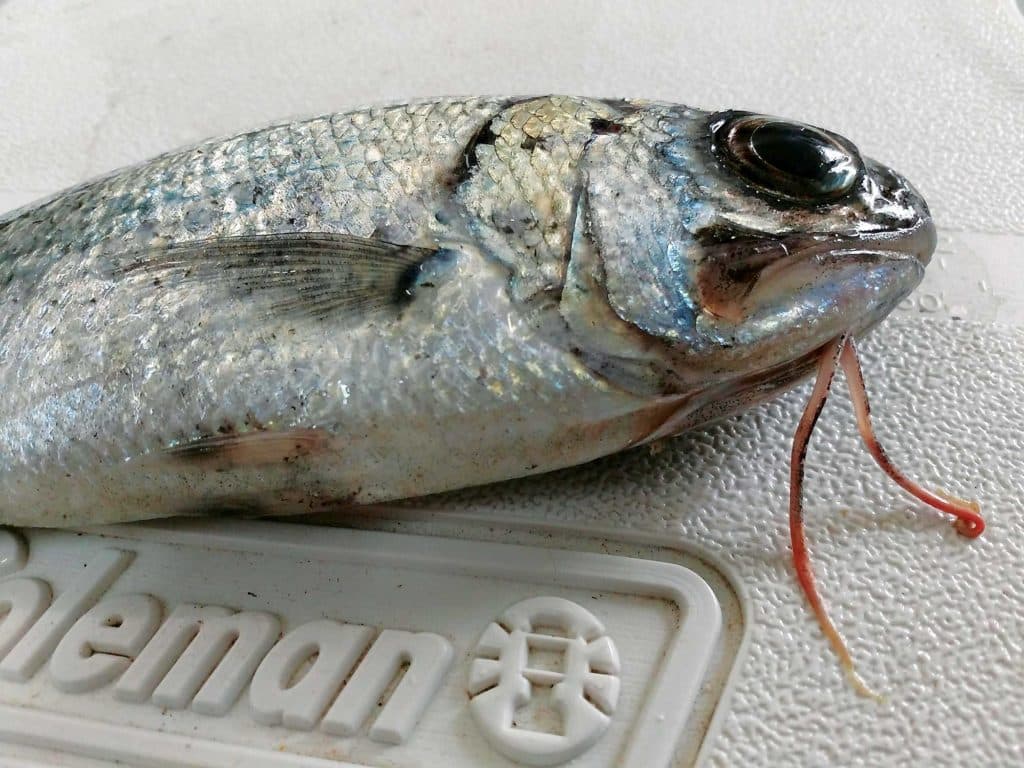
ANSWER:
That’s an interesting little fish, Ken. It’s a beardfish, Polymixia lowei. The beardfish family (Polymixiidae) is so-named for the pair of robust barbels that originate below the chin of beardfishes. The species you caught ranges from New York to French Guiana, in South America, including the Gulf of Mexico. I’m basing that species ID on where you caught the fish and its overall shape; I can’t see its dorsal fin well enough to count fin rays, which help distinguish the beardfish from another member of the family Polymixiidae that overlaps in its distribution, the stout beardfish, P. nobilis. Eight other species of beardfishes also inhabit the Atlantic and Pacific oceans. Beardfish appear to prefer soft-bottom areas along the lower continental shelf, as well as the continental slope at depths between 300 and 2,500 feet, although they’ve been reported from water as shallow as 165 feet. Beardfish reach a maximum known length of only about 8 inches. Due to their small size and deep-dwelling habits, they aren’t normally considered table fare.
—Ray Waldner
Read Next: Strange Fishes From the Deep – Tomato Cod and More
Sport Fishing‘s Prestigious International Panel of Experts
Northeast
Mike Fahay, Sandy Hook Marine Lab, New Jersey
Southeast
Ray Waldner, Ph.D., Palm Beach Atlantic University, Florida
Gulf of Mexico
Bob Shipp, Ph.D., University of South Alabama
West Coast
Milton Love, Ph.D., UCSB, California
Far Pacific
Ben Diggles, Ph.D., Queensland, Australia
Bluewater Pelagics
John Graves, Ph.D., Virginia Institute of Marine Science
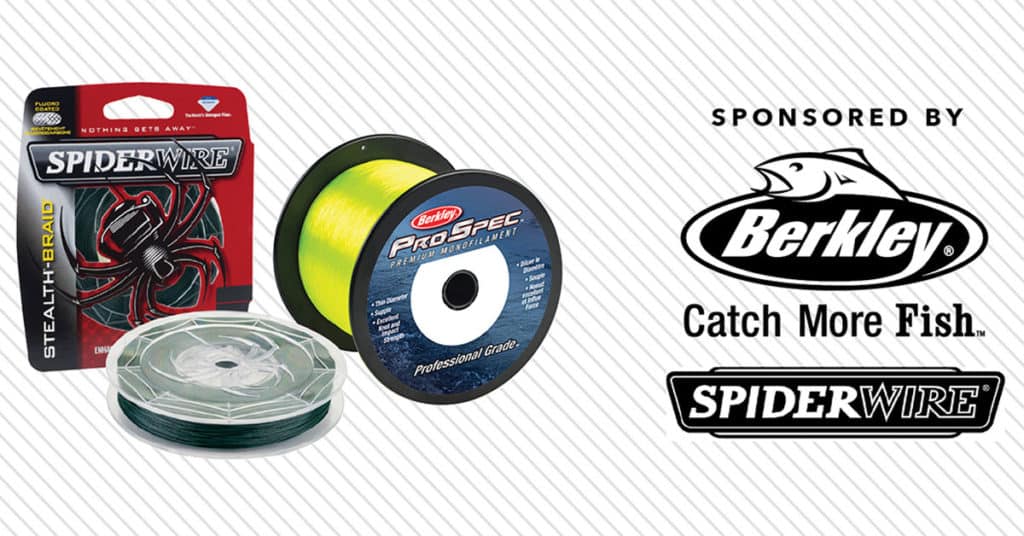
CHALLENGE OUR EXPERTS (And Win Up to 10,800 Yards of Line!)
Send in your question and any relevant photos of your mysterious catch or observation for our experts’ ID and feedback. If we publish your question and you have a shipping address within the United States or Canada, you’ll win a 3‑pound spool of Berkley Pro Spec ocean-blue or fluorescent-yellow monofilament (1,000 to 10,800 yards, depending on line strength) or a 1,500‑yard spool of Spiderwire Stealth braid up to 100‑pound‑test! Send questions and images via email to fishfacts@sportfishing.com (include your hometown) or via post to Sport Fishing Fish Facts, 460 N. Orlando Ave., Suite 200, Winter Park, FL 32789.

